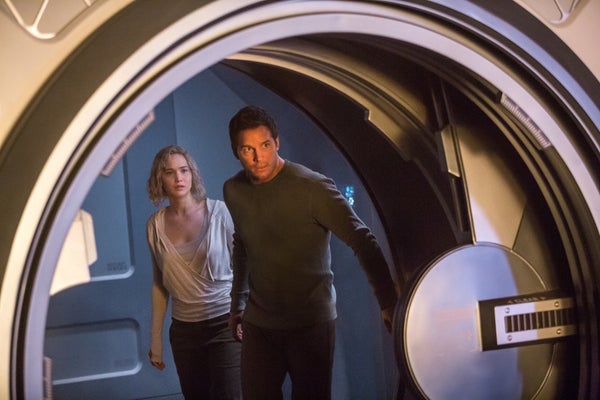It’s a nightmare scenario: You’re supposed to sleep through the 120-year journey to another star but you wake up way, way too soon. That’s what happens to Jim Preston (Chris Pratt) and Aurora Dunn (Jennifer Lawrence) onboard the starship Avalon, which is en route to establish a colony on the distant planet “Homestead” in the new movie Passengers. The film, which opens December 21, grapples with the technological and personal challenges of such an interminable journey, especially when—as they often do in the movies—things go wrong.
The film features some impressive zero-gravity effects—most notably a scene in which the ship’s artificial gravity fails while one character is taking a swim in the onboard lap pool—and tantalizing visions of the kind of entertainment and amenities that might be available on a futuristic spaceship. But it shows that even the most tricked-out of luxury starships can be devastatingly boring and lonely when you know you won’t live to reach your destination.
On supporting science journalism
If you're enjoying this article, consider supporting our award-winning journalism by subscribing. By purchasing a subscription you are helping to ensure the future of impactful stories about the discoveries and ideas shaping our world today.
Scientific American spoke to Passengers’ screenwriter Jon Spaihts, a self-avowed lifelong sci-fi fan, about the science and sociology of interstellar travel.
[An edited transcript of the interview follows.]
To me, Passengers fits into a larger trend, of which I’m a big fan—of science fiction movies taking the science of space travel a lot more seriously than they have in the past. Why do you think that might be happening?
I absolutely agree and I’m thrilled to see it as well. I think there are a few reasons for it. One is that in some ways very realistic, grounded sci-fi is more expensive to shoot than space opera can be. Space opera with people running around on flat decks with artificial gravity can be basically a police procedural or war movie with different costumes. But realistic space films have to grapple with zero gravity, nonflat environments to create artificial acceleration, and the unusual and counterintuitive modes of movement in zero gravity. It’s very difficult to understand orbital mechanics and microgravity maneuvering, and you have to teach the audience about them. Now with the International Space Station and with the maturation of filmmaking technology that makes zero gravity much more attainable, we’re seeing a natural movement toward grounded, real day-after-tomorrow spaceflight.
How did the concept for Passengers come to you?
It began with an attempt to come up with a fresh science fiction story that broke out of the war mold or the future dystopia mold—I wanted to find a new form of story to tell. The thing that came to me was long-haul colony ships. The reality is that in the physics of our universe as we understand it, there is unlikely to be a hyperspace or faster-than-light speed drive, so that means journeys of decades, centuries or even thousands of years. The prospect of those sleeping ships moving out to the stars has always appealed to me. When I thought about something going wrong on one of those ships and people waking up far too soon, the story unfolded and the spine of passengers emerged.
How concerned were you with scientific accuracy when writing this story?
It’s a hazard of dealing with science in the movies in that it is tempting and sometimes necessary to create conflict and explore the things that could go wrong, and in that way science is often ill-served. But it is probably more important to me that I get the science right than it is to anyone else involved in the process. That is always the corner I’m fighting—the direction of rigor. For narrative reasons, it is inevitably necessary to bend the rules a little bit in ways that I hesitate to do. But ultimately the story is the most important thing. I hold the line as best I can and I think that went pretty well with this film.

The space travelers visit their starship’s infirmary in the film “Passengers.” Credit: 2016 Columbia Pictures Industries, Inc. All Rights Reserved
If we ever do launch a human mission to another star, it will inevitably be a trip of extremely long duration. How did that aspect of time affect your storytelling?
One of the fascinating things about space travel and the speed of light limit is that the cultural lags you can see between Earth and the cities on the remote periphery of an interstellar civilization would be wildly exaggerated. Say another planet lies 60 light-years away and you can make the crossing in 120 years—then the best information you have is already 60 years old. That’s the fastest anything can happen. I think that’s fascinating, and I also think it’s the shape of the future.
Maybe we’ll find a way to squeeze or stretch space or poke wormholes through it, but barring some technology of that kind the only interstellar civilization we can imagine would therefore involve those leaps of time. Those long flights have two options: Either everyone aboard stays asleep and you find a way to suspend time for those people or they have generations live and die onboard.
I think they’re both fascinating stories. I would happily pursue a generation ship story at some point, but that is inevitably a story of multiple generations and aging characters up. It’s a completely different enterprise. Of necessity, most stories told on generation ships want to take a wide view because you’re watching a mini civilization. The sleeper ship allows characters to make entire journeys themselves and lets us follow a couple of individuals closely.
